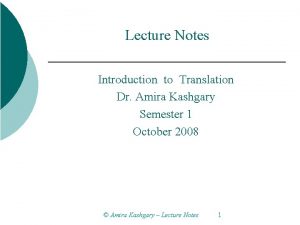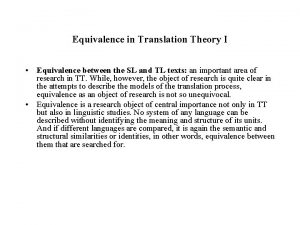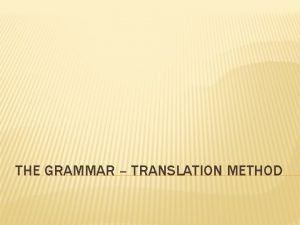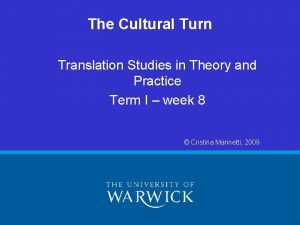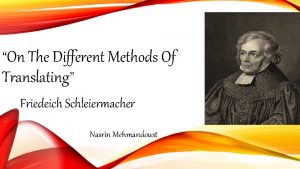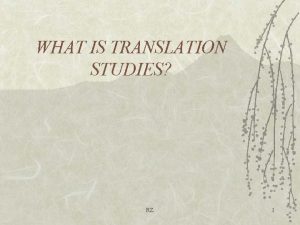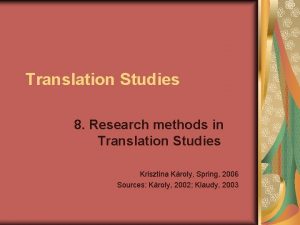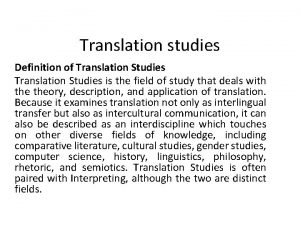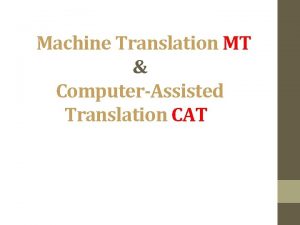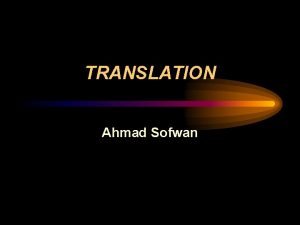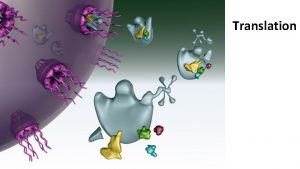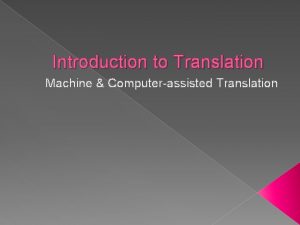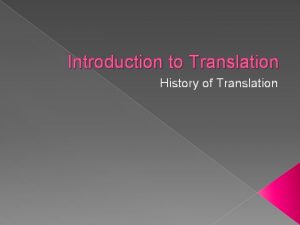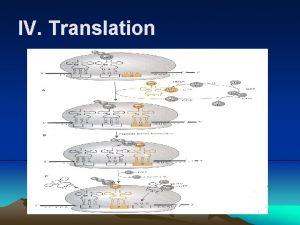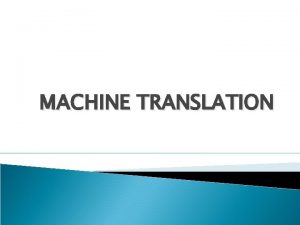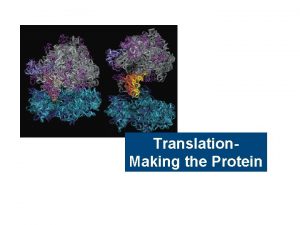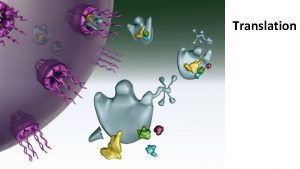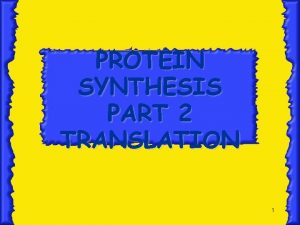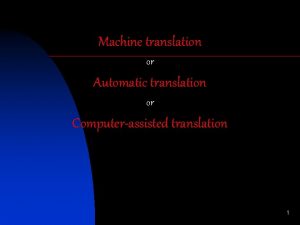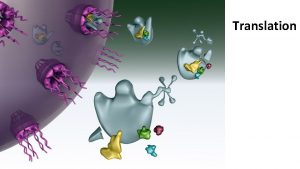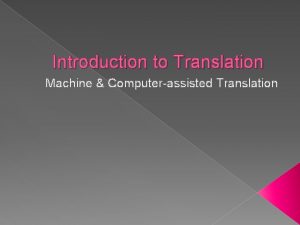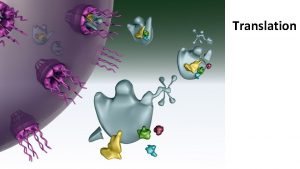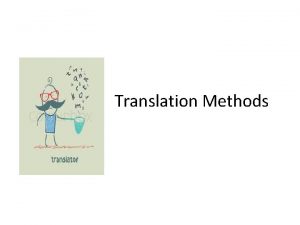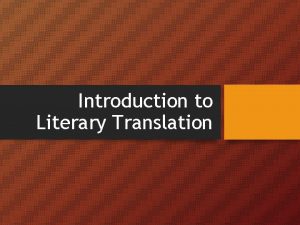Translation Studies Transfer Studies Instructor Name Assistant Professor




















- Slides: 20

Translation Studies &Transfer Studies Instructor Name: Assistant Professor Dr. Raheem ALKaabi Presented by Khalida Hamid

Introduction In Translation Studies there is no unified concept of transfer. What distinguishes transfer concepts from concepts of translation, is that ‘translation’ is frequently seen as a more constrained mode of transfer associated with equivalence or invariance requirements (Koller 1992). In contrast, transfer concepts include transformations of texts and other media produced with a functionalist objective, i. e. , with the intention of obtaining a TT or medium that fulfils specific functions for its audience in the TC, rather than the criterion of invariance in relation to the source material. Such kind of Transfer is termed adaptation or version. To what extent the concepts of translation and transfer overlap depends on the paradigm of translation theory from which one starts.

Definition s Transfer Studies is defined as “a transdisciplinary science whose objective is to investigate the principles, methods and strategies of making knowledge accessible in a selective and sustained way in the wake of a flood of information and knowledge explosion” (Antos , 2001: 5). “ Transfer Studies investigates the conditions, principles, forms and strategies as well as problems and chances of creating metaknowledge about knowledge for the purpose of making (specialized) knowledge available in an unrestricted manner to all people who might be interested in it ”


Widening the scope of Translation Studies Equivalence-oriented paradigm • the functionalist paradigm • the descriptive paradigm •

Equivalence-oriented paradigm Functionalist Perspective A. Conceptual Equivalence cannot be achieved ondifficulties: all levels to the same • degree at the same time. Equivalence requirement are replaced with the requirement • of appropriateness for a specific audience and a specific purpose (skopos) Equivalence is impossible : • A text is not a text per se; it only becomes a text in the individual comprehension process of each recipient (Vermeer 1986: 42). As a consequence, each ST is understood in a different way by each recipient. So, There as many STs as there are recipients. B. Conceptual equivalence-oriented approachesdifficulties: ignore those types of • transfer that do not aim at equivalence and which consequently are not termed translations but adaptions.

Functionalist approaches

Skopos theory • Translation is a kind of transubstantiation; one poem becomes another. You can choose your philosophy of translation just as you choose how to live: the free adaptation that sacrifices detail to meaning, the strict crib that sacrifices meaning to exactitude. The poet moves from life to language, the translator moves from language to life; both, like the immigrant, try to identify the invisible, what’s between the lines, the mysterious implications. Canadian poet Anne Michaels: Fugitive Pieces (Anne Main ideas behind skopos theory assert that skopos or purpose influences a translation, and not the source text alone, and that skopos determines 'free' or 'faithful' translation. It emphasizes the need for translators to take into consideration diverse factors such as the culture of intended readers and the client commissioning the work, as well as the function of the text in the given culture.

Skopos is the Greek word for aim, finality, objectives, and/or intention” theory 1. The recognition that the (ST) is not responsible for its effects on the translation process. Skopos is controlled and specified by the (TT) users, either readers or listeners, and their situation and cultural background 2. A TT is an offer of information in a target culture and a TL, which is related to an offer of information (the ST) in a source culture and SL. This rule links the ST and TT and their function to their separate linguistic and cultural backgrounds. 3. The function of the TT in its destination cultural context is not necessarily the same as the function of the ST in its source cultural context.

Holz-Manttari’s theory of translatorial action • Translatorial action can do without any source text at all. (she avoids the term translation because it implies that there must be something that is translated) • Translatorial Interlingual translation is “translatorial action from a source Action text ” and is a “communicative process” and can even take place without any fixed source text at all. • Translatorial action views translation as purpose-driven, outcome-oriented human interaction and focuses on the process of translation as message-transmitter compounds. *She abandons Vermeer ’s requirement that translation must somehow involve an “imitating ” feature (Nord 1997: 142). *She *focuses very much on producing a TT that is functionally communicative for the receiver. This means, for example, that the form and genre of the TT must be guided by what is functionally suitable in the TT culture, rather than by merely copying the • ST profile.

Vermeer ’s Skopos Theory A TT is an offer of information in a target culture and a TL, which is related to an offer of information (the ST) in a source culture and SL. This rule links the ST and TT and their function to their separate linguistic and cultural backgrounds. • “What the skopos states is that one must translate, consciously and consistently, in accordance with some principle respecting the target text. The theory does not state what the principle is: this must be decided separately in each specific case. ” (Vermeer 1989: 234) • Vermeer (Ibid. : 19) says that the applicability of translation depends on the existence of: • a source text, • a transfer across cultural boundaries, • a transformation which can somehow be described as “imitating, ” “simulating ” or “representational. ”

Nord’s functionalist approach • In addition to skopos adequacy, she demands loyalty towards the source text author, the commissioner and the audience. • Nord (2005: 31– 2) also takes issue with Holz-Mänttäri’s disregard of the ST. She stresses that, while ‘functionality is the most important criterion for a translation’, this does not allow the translator absolute licence. There needs to be a relationship between ST and TT, and the nature of this relationship is determined by the purpose or skopos. This ‘functionality plus loyalty ’ principle underpins Nord’s model.

Criticisms of Functionalism • Source text is ‘dethroned’ • Applicability to literary translation? • No distinction between ‘good’ and ‘bad’ purposes • Fascination with terminology and inconsistent use of this • Not based on empirical studies • Concepts of source and target culture underdefined • Not all actions have an intention (works of art)

From interlingual to intralingual translation Jakonbson categorized translation into: 1. Intralingual gnidrawer ro noitalsnart is an interpretation of verbal signs of other signs of the same language. 2. Intralingual reporp noitalsnart ro noitalsnart is an interpretation of verbal signs by means of some other language 3. Intersemiotictranslation of transmision is an interpretation of verbal signs by means of signs of non-verbal signs systems.

Descriptive Translation Studies (DTS) The descriptive translation theorist starts • with a practical examination of a corpus of texts and then seeks to determine the norms and constraints operating on these texts in a specific culture and at a specific moment in history. It offers a method for the comparative • analysis of source and (already translated) target texts.

Translation Studies &Transfer Studies compared • The evaluation of knowledge (with respect to translation, this relates to its relevance to the skopos) • Its function- and audience-specific transformation. • Translation management (including terminology management) as a cooperative process

Translation quality assessment in the functionalist paradigm • Honig (1998: 15). criticized that the functionalist paradigm has not provided a method for translation quality assessment within this paradigm, and noted that, when it comes to translation quality assessment, “linguistic evaluation on a contrastive basis is reintegrated through the backdoor with the critic claiming that it is a typical reader ’s response” •


Conclusion Transfer studies include transformations of texts • and other media produced with a functionalist objective. Widening the scope of Translation Studies is a • logical consequence of the development of TS and the fact that cognitive processes involved in intralingual text optimizations may be an integral component of interlingual translation in the functionalist paradigm. The functionalist paradigm was criticized for not having a method for translation quality assessment within this paradigm.

References Jakobson, Roman. 1966. “On Linguistic Aspects of Translation”. In On Translation, R. Brower (ed. ), 232– 238. New York: Oxford University Press. Koller, Werner. 1992. Einfuhrung in die Ubersetzungswissenschaft. Heidelberg, Wiesbaden: Quelle & Meyer. Nord (1997) Translating as a Purposeful Activity: Functionalist Approaches Explained, Manchester: St Jerome. Vermeer, H. J. (1989) ‘Skopos and commission in translational action’, in L. Venuti (ed. ) (2004), pp. 227– 38. • •
 Promotion from assistant to associate professor
Promotion from assistant to associate professor Fok ping kwan
Fok ping kwan Name a line containing point a
Name a line containing point a Example of semantic translation
Example of semantic translation Voice translation profile
Voice translation profile Square root function transformations
Square root function transformations 10 noun phrases
10 noun phrases Professor name style
Professor name style A disturbance that transfers energy is called
A disturbance that transfers energy is called Translation studies lecture notes
Translation studies lecture notes Equivalence of translation
Equivalence of translation Equivalence in difference jakobson
Equivalence in difference jakobson Merits and demerits of translation method
Merits and demerits of translation method Cultural turn in translation
Cultural turn in translation On the different methods of translating
On the different methods of translating Wolfram wills
Wolfram wills Paradigm shift from women studies to gender studies
Paradigm shift from women studies to gender studies Tipología de los participantes y como tratarlos
Tipología de los participantes y como tratarlos Basic instructor course tcole
Basic instructor course tcole Basic instructor course texas
Basic instructor course texas Basic instructor course #1014
Basic instructor course #1014









